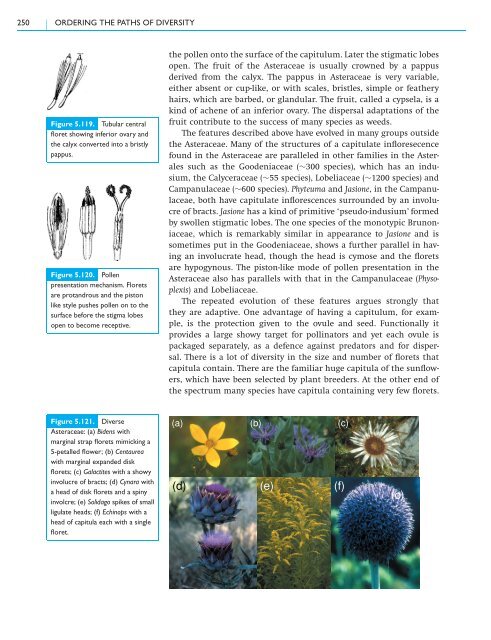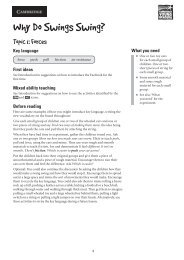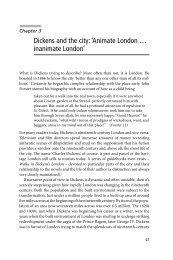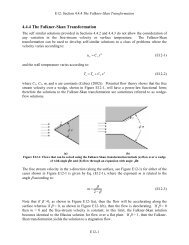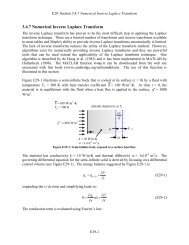5.3 Class Magnoliopsida – flowering plants - Cambridge University ...
5.3 Class Magnoliopsida – flowering plants - Cambridge University ...
5.3 Class Magnoliopsida – flowering plants - Cambridge University ...
You also want an ePaper? Increase the reach of your titles
YUMPU automatically turns print PDFs into web optimized ePapers that Google loves.
250 ORDERING THE PATHS OF DIVERSITY<br />
Figure 5.119. Tubular central<br />
floret showing inferior ovary and<br />
the calyx converted into a bristly<br />
pappus.<br />
Figure 5.120. Pollen<br />
presentation mechanism. Florets<br />
are protandrous and the piston<br />
like style pushes pollen on to the<br />
surface before the stigma lobes<br />
open to become receptive.<br />
Figure 5.121. Diverse<br />
Asteraceae: (a) Bidens with<br />
marginal strap florets mimicking a<br />
5-petalled flower; (b) Centaurea<br />
with marginal expanded disk<br />
florets; (c) Galactites with a showy<br />
involucre of bracts; (d) Cynara with<br />
a head of disk florets and a spiny<br />
involcre; (e) Solidago spikes of small<br />
ligulate heads; (f) Echinops with a<br />
head of capitula each with a single<br />
floret.<br />
the pollen onto the surface of the capitulum. Later the stigmatic lobes<br />
open. The fruit of the Asteraceae is usually crowned by a pappus<br />
derived from the calyx. The pappus in Asteraceae is very variable,<br />
either absent or cup-like, or with scales, bristles, simple or feathery<br />
hairs, which are barbed, or glandular. The fruit, called a cypsela, is a<br />
kind of achene of an inferior ovary. The dispersal adaptations of the<br />
fruit contribute to the success of many species as weeds.<br />
The features described above have evolved in many groups outside<br />
the Asteraceae. Many of the structures of a capitulate infloresecence<br />
found in the Asteraceae are paralleled in other families in the Asterales<br />
such as the Goodeniaceae (∼300 species), which has an indusium,<br />
the Calyceraceae (∼55 species), Lobeliaceae (∼1200 species) and<br />
Campanulaceae (∼600 species). Phyteuma and Jasione, in the Campanulaceae,<br />
both have capitulate inflorescences surrounded by an involucre<br />
of bracts. Jasione has a kind of primitive ‘pseudo-indusium’ formed<br />
by swollen stigmatic lobes. The one species of the monotypic Brunoniaceae,<br />
which is remarkably similar in appearance to Jasione and is<br />
sometimes put in the Goodeniaceae, shows a further parallel in having<br />
an involucrate head, though the head is cymose and the florets<br />
are hypogynous. The piston-like mode of pollen presentation in the<br />
Asteraceae also has parallels with that in the Campanulaceae (Physoplexis)<br />
and Lobeliaceae.<br />
The repeated evolution of these features argues strongly that<br />
they are adaptive. One advantage of having a capitulum, for example,<br />
is the protection given to the ovule and seed. Functionally it<br />
provides a large showy target for pollinators and yet each ovule is<br />
packaged separately, as a defence against predators and for dispersal.<br />
There is a lot of diversity in the size and number of florets that<br />
capitula contain. There are the familiar huge capitula of the sunflowers,<br />
which have been selected by plant breeders. At the other end of<br />
the spectrum many species have capitula containing very few florets.<br />
(a) (b) (c)<br />
(d) (e) (f)<br />
(c)


